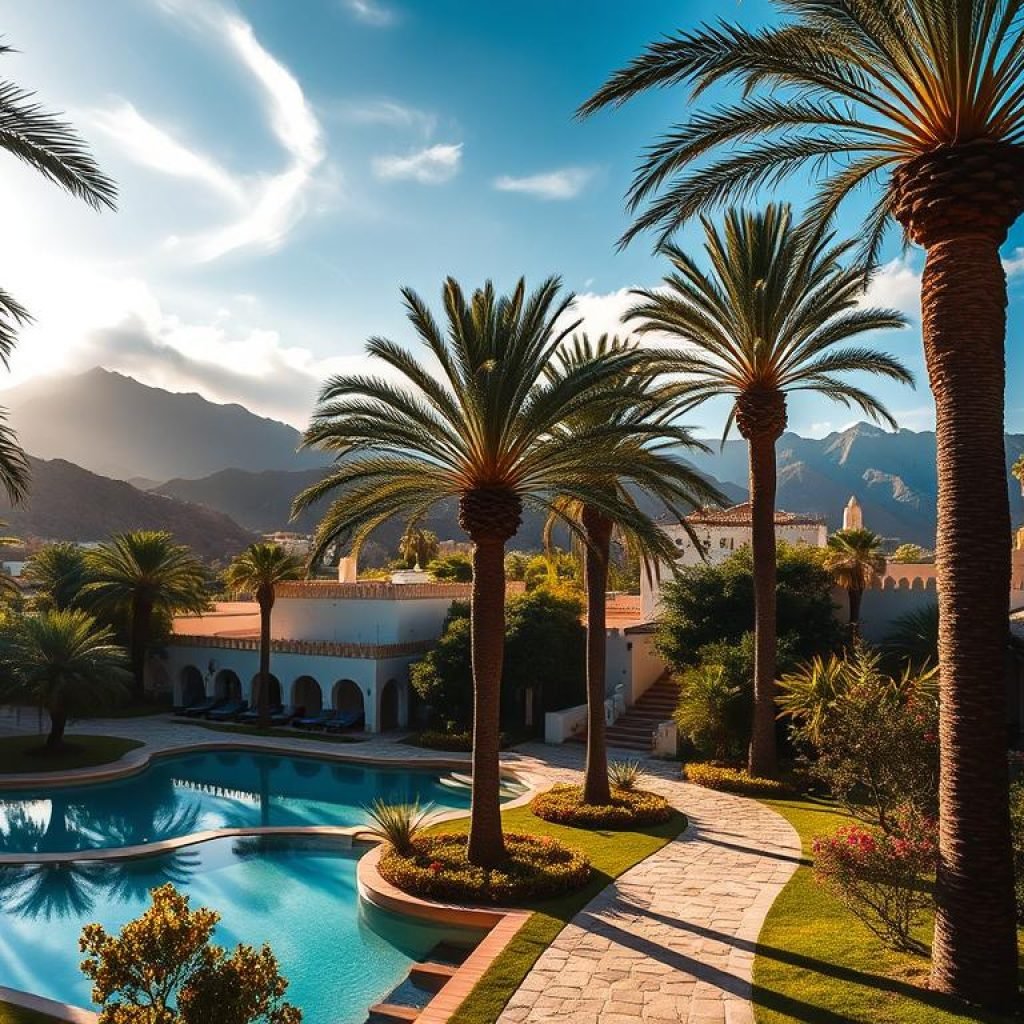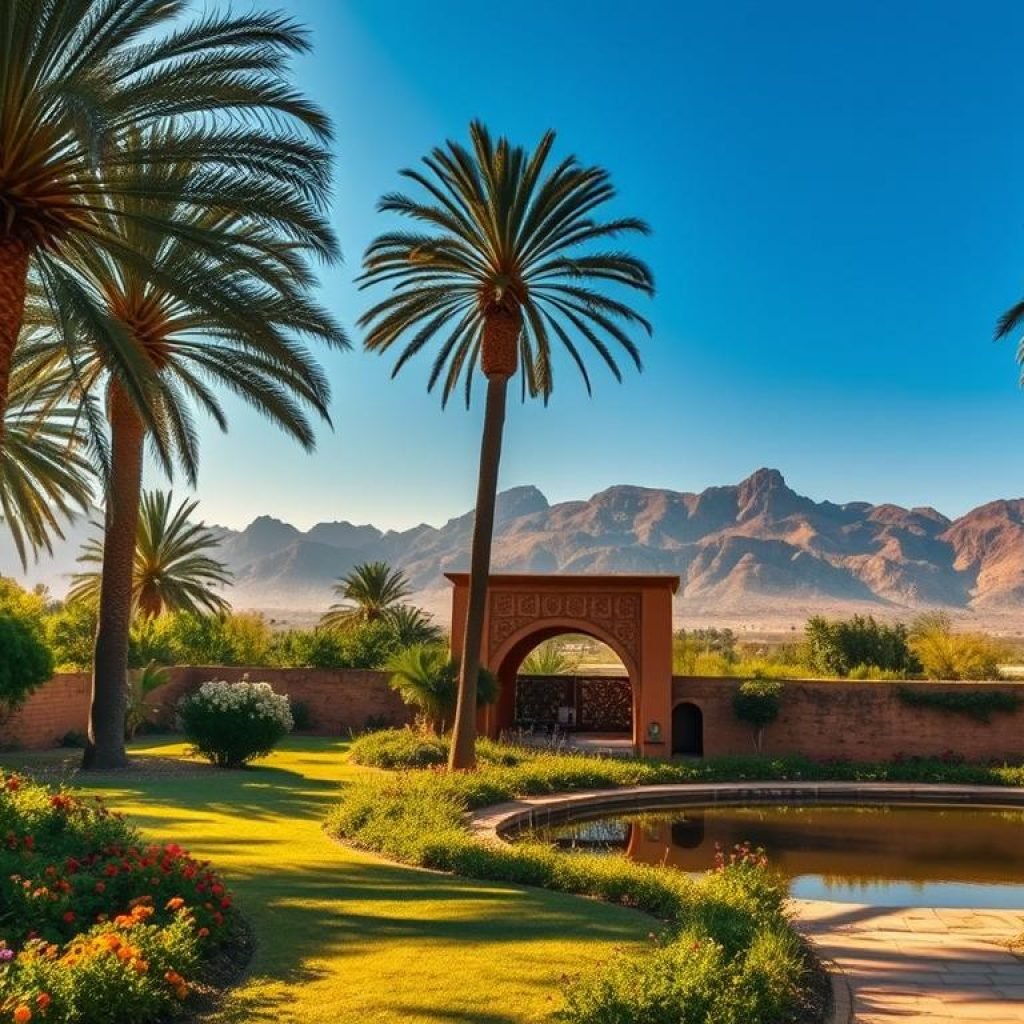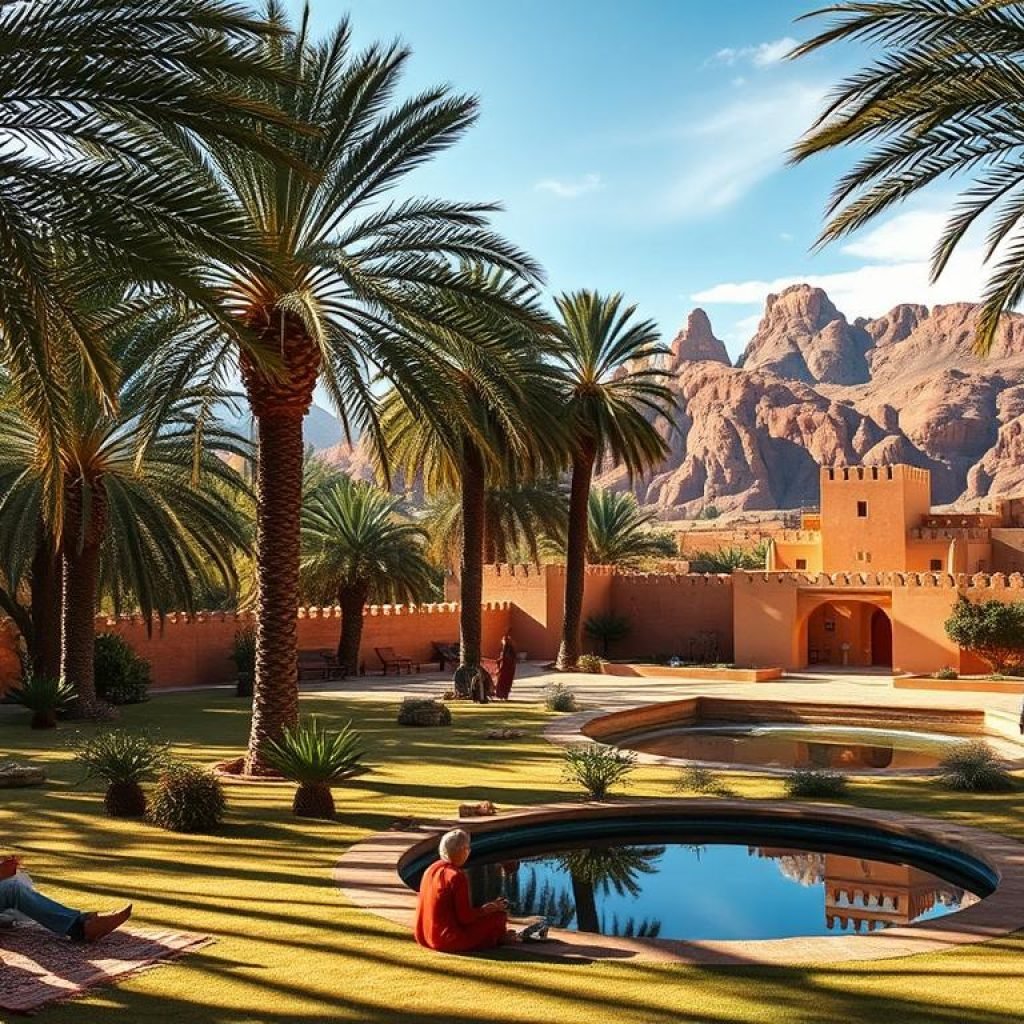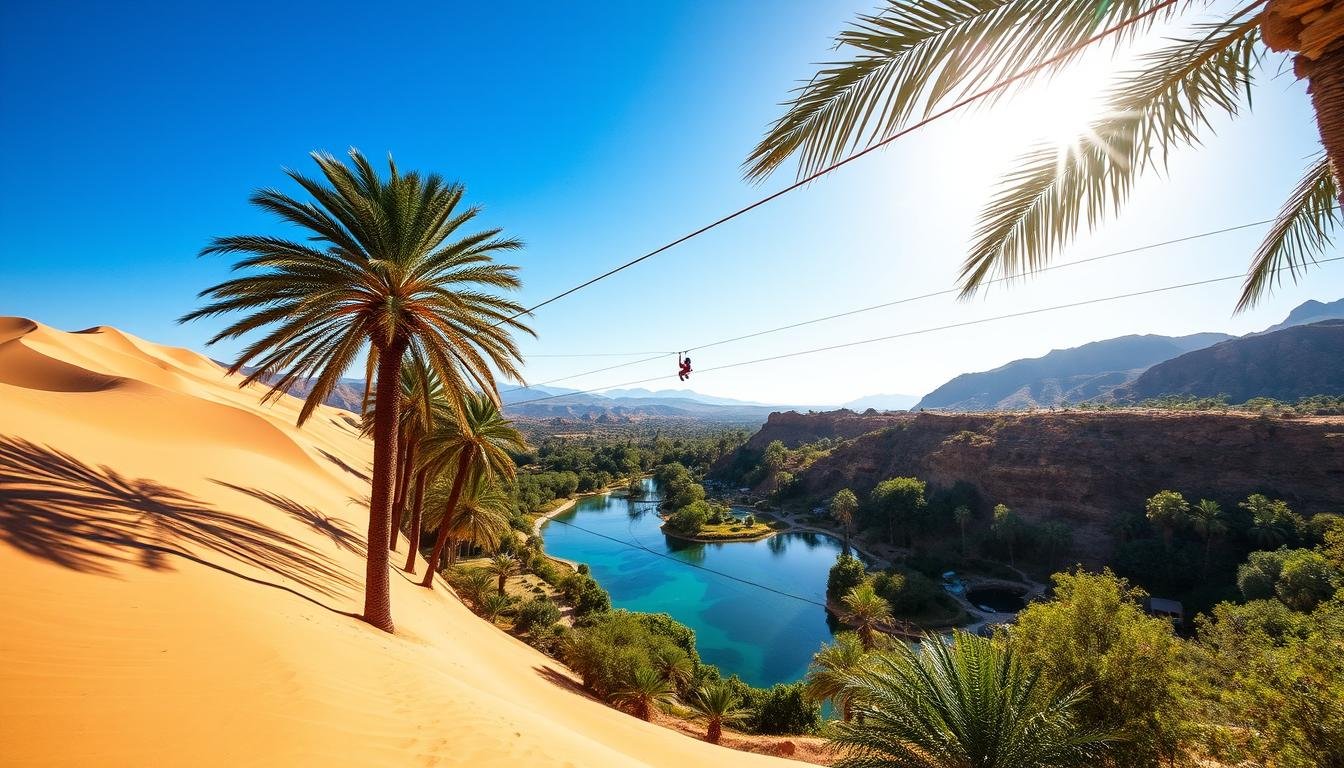Did you know Terres D’Amanar has a 700-foot zip line over a gorge? It offers amazing views of Morocco’s oases. This is just one of the many adventures waiting for you in Morocco’s beautiful desert landscapes.
Morocco is perfect for those who love outdoor activities and culture. You can explore the majestic palm groves and vibrant markets in each oasis. Each one offers a unique and unforgettable experience.
Introduction to Zip Lining in Morocco
Zip lining is a great way to see Morocco’s oases from above. You can try the Aerial Park’s 306-meter zip line for an exciting adventure. Morocco’s oases have something for everyone, whether you love nature or thrill-seeking.
Key Takeaways
- Terres D’Amanar features a 700-foot zip line across a gorge
- Morocco oases offer a unique blend of culture and outdoor activities
- Oases in Morocco provide breathtaking scenery and exciting adventures
- Zip lining is a great way to experience the thrill of Morocco’s desert landscapes
- Moroccan desert oasis culture is rich and vibrant, with many opportunities to explore
- Visitors can enjoy a range of activities, from zip lining to guided walking tours, in Morocco’s oases
Introduction to Morocco’s Oases
Morocco’s oases are truly amazing, covering 15% of the country. They are home to about 2 million people. These Saharan oases are stunning and very important for Morocco’s culture and economy. To Explore Moroccan oases, you can join guided tours like Oasis tours in Morocco. They offer a special experience.
The oases are spread across different areas, each with its own charm. The Draa Valley is famous for its palm groves. The Todra Gorge is known for its towering dunes. Knowing how oases are part of Moroccan culture helps us understand the country’s rich heritage.
- Two-thirds of Morocco’s oases have been lost in the past century.
- The number of palm trees in Morocco has decreased from 15 million to just over 6 million in the last century.
- The Moroccan government has planted over 3 million palm trees as part of a program initiated in 2016 to save the oases.
Top Oasis Destinations in Morocco
Choosing the best oases in Morocco is exciting. These places mix natural beauty, history, and culture. The Draa Valley and Todra Gorge stand out for their stunning views and traditional Moroccan life.
The Draa Valley shows off Morocco’s culture with its palm groves, ancient kasbahs, and lively markets. The Todra Gorge is perfect for outdoor lovers, with its amazing views, trails, and rock climbing spots. Both are top picks for seeing Morocco’s beauty and history.

- Lush palm groves and traditional Berber villages
- Ancient kasbahs and historic sites
- Breathtaking scenery and outdoor activities
- Rich cultural heritage and vibrant local markets
Looking for history, culture, or adventure? Morocco’s oases have it all. Their mix of nature and Moroccan traditions makes them a must-see for travelers.
Exploring Morocco’s Hidden Oases
For those seeking adventure, Morocco’s hidden oases are a goldmine of discovery. Nestled in the Sahara desert, these natural wonders showcase the country’s rich culture and breathtaking landscapes. Places like Skoura offer a serene retreat, with its palm groves and ancient kasbahs.
Exploring these oases through desert oasis excursions is a great way to dive into local culture and nature. Tafilalet, for instance, is a cultural hub with influences from Berber, Arab, and French traditions. Here, visitors can wander through kasbahs, palm groves, and villages, and feel the locals’ warm welcome.
- The stunning natural beauty of the palm groves and surrounding landscape
- The rich cultural heritage of the oases, including historic kasbahs and traditional villages
- The unique blend of Berber, Arab, and French influences in the oasis of Tafilalet
- The opportunity to experience the local culture and hospitality of the people
Whether you’re after a quiet escape or an exciting journey, Morocco’s hidden oases are a must-see. Their natural splendor, cultural depth, and friendly locals make them unforgettable. So, why not take a desert oasis excursion in Morocco and uncover its Sahara desert’s hidden treasures?
Planning Your Oasis Adventure
Planning a trip to Morocco’s oases requires thinking about the best time to go. Spring and autumn are the best seasons. The weather is mild, making your trip more enjoyable.
Before you go, pack the right clothes and stay hydrated. Also, remember to respect local customs. For more tips, check out Morocco desert tour guides.
Popular activities include camel trekking and camping under the stars. The Erg Chebbi dunes are stunning, with dunes up to 150 meters high. Morocco’s oases offer something for everyone, whether you want adventure or relaxation.

- Research the best time to visit, taking into account the weather and local events
- Pack accordingly, including comfortable clothing and necessary supplies
- Respect local customs and traditions, especially when interacting with local communities
By following these tips and planning well, you’ll make memories that last a lifetime in Morocco’s oases.
Cultural Experiences in Morocco’s Oases
Exploring Moroccan oases reveals a rich cultural heritage. Each region has its own unique traditions. You can enjoy vibrant souks, traditional music, and dance performances. Oasis tours in Morocco offer a chance to dive into these cultures, experiencing the locals’ warm hospitality.
Attending a traditional festival or event is a great way to immerse yourself in local culture. The Oasis Festival, for instance, celebrates music, dance, and art in Morocco’s oases. You can also visit markets to find unique handicrafts and taste local dishes. The call to prayer (adhan) is a daily reminder of Islamic practices in Morocco.
For a deeper cultural experience, consider a guided tour or cooking class. These activities let you learn about local customs and try Moroccan cuisine. Morocco’s rich culture and warm people make it a place with lasting memories.
Some top cultural experiences in Morocco’s oases include:
* Attending a traditional music or dance performance
* Visiting a local market or souk
* Taking a cooking class to learn about Moroccan cuisine
* Attending a festival or event, such as the Oasis Festival
* Exploring the vibrant streets and alleys of the oases, where you can discover unique handicrafts and try local food.
Outdoor Activities in Morocco’s Oases
Visitors to Morocco’s oases can enjoy many outdoor activities. These places are perfect for those who love adventure. You can hike, trek, rock climb, or go on desert safaris. The Draa Valley is great for hiking and trekking, with its beautiful landscapes and ancient villages.
The Todra Gorge near Tinghir is perfect for rock climbing. It has tall canyon walls that attract many adventurers. Erg Chebbi near Merzouga is famous for its huge sand dunes. It’s one of Morocco’s most beautiful desert landscapes.

- Hiking and trekking through scenic valleys and ancient villages
- Rock climbing in the Todra Gorge and other canyon walls
- Desert safaris, including camel rides and 4×4 excursions
- Stargazing in the clear desert skies
These activities let visitors see Morocco’s natural beauty and culture. They make any trip to Morocco’s oases unforgettable.
Historical and Architectural Significance of Morocco’s Oases
Morocco’s oases, including those in the Saharan region, are rich in cultural heritage. They have many historic sites and traditional architecture. This shows the country’s complex history and cultural influences.
The ancient kasbahs stand as a symbol of the region’s importance and cultural value. These structures have majestic walls and intricate decor.
Visitors to Morocco’s oases can see historic sites like the Ksar of Ait-Ben-Haddou. They can also admire the traditional architecture. This architecture combines Berber, Arab, and French styles.
The oases in Morocco, like the Draa Valley and the Todra Gorge, are known for their well-preserved architecture. Many buildings have intricate tile work and carved wood.
The historical significance of Morocco’s oases is clear in their architecture and decor. Historic sites, such as the Ksar of Ait-Ben-Haddou, show traditional Moroccan architectural motifs. These include arches, domes, and minarets.
The use of local materials, like mud and thatch, has helped keep the oases’ architecture traditional.
Some notable examples of traditional architecture in Morocco’s oases include:
- The Ksar of Ait-Ben-Haddou, a UNESCO World Heritage Site and one of the most well-preserved traditional villages in Morocco
- The Kasbah of Taourirt, a 19th-century palace in the city of Ouarzazate
- The Medina of Marrakesh, a historic walled city with a rich cultural heritage
Overall, Morocco’s oases, including the Saharan ones, are a unique and fascinating place. They are perfect for those interested in history, culture, and traditional architecture.
Practical Tips for Visiting Morocco’s Oases
Planning a trip to Morocco’s oases requires some thought. The oases are spread across the country, and reaching them can be exciting. Before you go, look into the best ways to get there and around.
Getting There and Getting Around
You have several travel options, like buses, taxis, or renting a car. Morocco’s fuel prices are low, which helps if you drive. Also, many tours offer guided visits to the oases. This can make your trip easier and more enjoyable.
Accommodation and Dining Options
There’s a wide range of places to stay, from riads to hotels. You’ll find many restaurants, serving both local and international food. Be sure to try local dishes like dates and tagines while you’re there.
Respecting Local Customs and Environment
When you visit Morocco oases, it’s key to respect local customs and the environment. These places are not just natural wonders. They are also homes to unique cultures and traditions. As a responsible traveler, being mindful of cultural sensitivities is crucial.
For example, modest dress is recommended. Women should wear dresses, shorts, and skirts that fall at least to the knee. This shows respect for the local culture.
In Saharan oases, taking care of the environment is also important. Morocco works to protect its environment through national and international treaties. Water and energy are scarce, so travelers need to use them wisely.
Simple actions like reducing water usage and turning off lights can help a lot. This shows respect for the environment and helps preserve it for future generations.
It’s also good to support fair trade by buying local handicrafts. This helps the local economy and preserves traditional crafts. By respecting local customs and the environment, travelers can have a better experience. They also help keep Morocco oases and Oases in Morocco preserved for everyone.
Health and Safety in Morocco’s Oases
Visiting Morocco’s oases requires careful steps to stay healthy and safe. Travelers should worry about getting travelers’ diarrhea. This can be prevented by using hand sanitizer and being careful with food and water.
It’s also important to know about other health risks. These include heat stroke and diseases like Hepatitis A, Typhoid, and Rabies. Rabies is a big concern for those in rural areas or doing outdoor activities. Getting vaccinated before visiting is a good idea.
Here are some tips for a healthy and safe trip to Morocco’s oases:
- Drink lots of water to stay hydrated
- Stay away from henna tattoos with harmful chemicals
- Watch out for sandstorms and flash floods
- Protect yourself from petty theft
By following these tips and being aware of health risks, you can enjoy Morocco’s oases safely. This includes the best places to visit in Morocco.
Conclusion
As we wrap up our exploration of Morocco’s oases, it’s key to think about their importance. These Saharan oases are more than just stunning sights. They are also lively communities that have learned to live with the desert’s harsh conditions. Each oasis, with its palm groves and bustling markets, has its own special vibe.
It’s vital to protect these oases. Desertification is a growing threat, and we must act to safeguard these special places. By supporting eco-friendly tourism and conservation, we can help keep Morocco’s oases alive. The traditional irrigation systems, like the khettara, are crucial for these ecosystems’ survival.
Some interesting facts about Morocco’s oases are:
- The Tafilalet region has 570 khettaras, including some that are no longer used.
- These khettaras cover about 16,000 hectares of land.
- On average, khettaras release around 700 liters of water every second.
In summary, Morocco’s oases are a treasure of natural beauty, history, and culture. By exploring these Saharan oases, we learn about the people who live there. As we move forward, preserving these unique ecosystems is crucial. We must ensure they remain vibrant for future generations.
Further Reading and Resources
For those eager to delve deeper into the wonders of Morocco’s oases, there are numerous informative resources available.
Travel guides offer a deep dive into Morocco’s oases. They highlight the cultural and historical importance of these lush desert oases. Online forums and travel blogs share firsthand experiences and tips from seasoned travelers.
Looking for the best oasis destinations, local customs, or adventure activities? These resources can guide you to create an unforgettable journey in Morocco’s oases.




Comment (0)